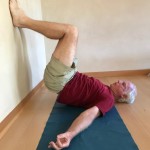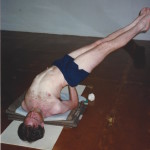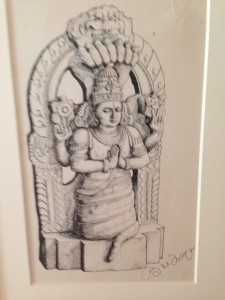(continued from previous post)
Breathing from The Three Burners
 From pelvic floor to navel = Lower Burner
From pelvic floor to navel = Lower Burner
From navel to diaphragm = Middle Burner
From the diaphragm to either 1st rib or roof of mouth to include the throat = Upper Burner
In Traditional Chinese Medicine, one of the 12 acupuncture meridians is known as the sanjiao or triple burner / triple heater. There is no equivalent in Western Medicine, but its role is the balance of yang/fire and yin/water through the core of the body. In general, fire rises and water sinks, so the sanjiao helps in remixing them so the tissues and cells are always at the optimal temperature and fluidity for health. This breathing exploration helps orient us to the inner spaces where this alchemy takes place.
Our primary shape for the breath is the sphere , expanding and condensing like the action of a Hoberman sphere seen here to the right. We always begin from the space inside of the sphere, not the sphere itself. Space moves the form, rather than the form moving the space. With inhalation, the space expands and the sphere does likewise. On exhalation, the space condenses and the form gets smaller. At the end of the exhalation, your attention is still inside the sphere, the sphere is just smaller.
, expanding and condensing like the action of a Hoberman sphere seen here to the right. We always begin from the space inside of the sphere, not the sphere itself. Space moves the form, rather than the form moving the space. With inhalation, the space expands and the sphere does likewise. On exhalation, the space condenses and the form gets smaller. At the end of the exhalation, your attention is still inside the sphere, the sphere is just smaller.
Practice 1. Sitting or lying comfortably, align yourself, relax and bring your attention to the breath. Gradually focus your attention on the lower burner space, from the bottom of the pelvic floor to the navel. Imagine this space is spherical, with the center of the sphere in the center of the pelvis. Feel expansion in all directions on the in-breath and a slow release inwards on the out-breath. Stay with this for a few minutes, 9 breaths or whatever feels right.
When complete, pause for several breaths and then shift your attention to the middle burner, between the navel and diaphragm. Imagine a sphere centered between your two kidneys and allow the expanding and condensing sensations of the breathing fill this mid torso region. Stay for 9 breaths, or whatever, and then pause for several more.
Now bring attention to the upper burner area, with your imaginary sphere centered just behind the upper heart. Repeat as with the previous sections. Finish by feeling the breath, rooted in the lower burner, moving freely throughout the whole torso, keeping eyes, ears and spinal muscles soft.
Practice 2. Bowls and Domes
We will repeat the same steps as above, only this time noticing the ‘north and south poles’ of your sphere. In the lower burner, the north pole will be about four fingers above the navel, in the center of the body, the south pole, CV-1. The north pole holds the top of an expanding dome, like an umbrella, the south pole the base of an expanding bowl, like a flower pot.
The whole sphere continues to expand and condense, but our attention is only on the two energetic points along the median line, or chong mai. On the in-breath, feel the energy of the points, let the space expand and the structures respond. On the out breath, let the energy points and the space lead the condensing action. Let the structure follow. There will be no gripping or contractions this way.
With the middle burner, the north pole of the lower burner becomes the south pole of the middle burner. It descends bowl-like on the in-breath while the north pole, in the center of the diaphragm, ascends dome like. On the out breath they reverse.
In the upper burner, again there is a reverse. The center of the diaphragm, now the south pole descends bowl-like , while the north pole, mid-throat or top of the soft palate ascends. Again, on the out breath everything slowly reverses.
If you fell adventurous, play with the three burners. Imagine and breath with lower and middle as a single space, from diaphragm to pelvic floor. How is this different from the previous practice? How is it similar ? Then, middle and upper as one, with the diaphragm between the two. What do you feel in the various organs/tissues of the region. Finish by rooting in the lower burner and feeling the wholeness of the breath.
Climbing the Wall from the Three Burners
 An old favorite: Reminders:
An old favorite: Reminders:
A. engage and open K-1 on the feet and PC-8 on the hands
B. relax neck, shoulders, kidneys, spinal muscles. We are looking to feel the inner body lifting and the whole periphery hanging down.
C. Press down through K-1 to create the lift. The heels will rise up, but not because you are lifting them. Actually the ankles lift and the heels hang down from the back of the ankles. This keeps you in the Deep Front Line (anatomy trains) and not in the outer calf muscles.|
D. Ascend as high as possible and then descend slowly at first. Then, ascend and remain fully extended through core to fingertips and slowly release down without dropping your hands. This will alert you to the glue in and around the diaphragm and mediastinum.
New Practice: Combining the previous breath practice with the wall climb, begin by ascending and descending with you full attention on opening the lower burner, using the movement of the N and S poles to create a charged space. Then the middle burner, followed by the upper burner, same process. Expand the space, create a charge of vitality, feel the charge melting dense tissue. Then take a walk around the room, feeling the median line/chong mai as you move.
 New Practice: Combining Bhoga block bridge with tail lift from the previous post.
New Practice: Combining Bhoga block bridge with tail lift from the previous post.
Find a comfortable place for the block, staying grounded through K-1 in the feet and long through the core of the body. Begin to lift up vertebrae by vertebrae until you reach your limit. Then reverse, slowly returning, link by link in the vertebral chain, letting the anterior lumbar/psoas lengthen circularly to the floor while still lengthening the back body. This will keep you in the center. Move the block around or reverse its direction. If you only have a regular yoga block, roll up a blanket and place it on top of the block (not the full height!) to create a curved shape.
Notice how this action affects the three burners. The lower burner includes the deep groin muscles. Find a way to help them become more elastic. The middle burner includes the kidneys, liver, gall bladder, stomach, spleen and pancreas. This is the keystone of the backbends and if the breathing, space and energy charge can expand and open, the strain is removed from the spinal muscles and the core opens more deeply. The upper burner extends into the throat and soft palate. Energy can be trapped here. Height under the shoulders can help to elongate C-6 through T-2 or T-3 to open this inner channel. My face is redder than the torso, indicating a blockage. It is a work in progress.
 This inner experience can then be taken to sarvangasana and variations or viparita karani.
This inner experience can then be taken to sarvangasana and variations or viparita karani. 
 When you are inverted, the legs can really help create inner length. In shifting from extension to flexion and vice versa, the middle burner serves as the intermediary between front and back, upper and lower bodies. Photos above: young me, current me, fantasy me.
When you are inverted, the legs can really help create inner length. In shifting from extension to flexion and vice versa, the middle burner serves as the intermediary between front and back, upper and lower bodies. Photos above: young me, current me, fantasy me.
Part 3 coming next. Please write with questions about the practices. They are not always easy to express verbally, and the inner experience is totally impossible to verbalize. “The tao that ca be spoken is not the true Tao.”
PS: As I am posting this, California is again in the midst of conflagrations from hell. Hold us in your prayers.











